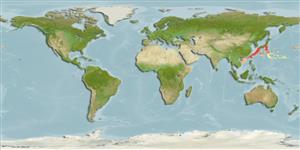Environment: milieu / climate zone / depth range / distribution range
Ecologia
marinhas batidemersal; intervalo de profundidade 500 - 1985 m (Ref. 7460). Deep-water; 35°N - 34°S, 102°E - 153°W
Northwest Pacific: Japan and Taiwan; most probably in East China Sea and/or the Okinawa Trough, but rarely in the South China Sea. No reliable reports outside this area and need to be checked.
Tamanho / Peso / Idade
Maturity: Lm ? range ? - ? cm
Max length : 14.0 cm SL macho/indeterminado; (Ref. 559)
Descrição suscinta
Chaves de identificação | Morfologia | Morfometria
A species belonging to the C. fimbriatus species group which is distinguished mainly from its congeners by having two large pale patches on its dorsal surface, one associated with the embedded third dorsal spine and another before the origin of the soft dorsal fin; mainly four neuromasts in the lower preopercular series (vs. mainly 3 in other congeners) (Ref. 94130).
Benthic (Ref. 58302). Edible (Ref. 637).
Ciclo de vida ou comportamento de acasalamento
Maturidade | Reprodução | Desova | Ovos | Fecundidade | Larvas
Masuda, H., K. Amaoka, C. Araga, T. Uyeno and T. Yoshino, 1984. The fishes of the Japanese Archipelago. Vol. 1. Tokai University Press, Tokyo, Japan. 437 p. (text). (Ref. 559)
Status na Lista Vermelha da UICN (Ref. 130435: Version 2024-1)
Ameaça para os humanos
Harmless
Uso pelos humanos
Pescarias:
Ferramentas
Relatórios especiais
Baixar XML
Fontes da internet
Estimates based on models
Preferred temperature (Ref.
123201): 3.5 - 6.5, mean 4.6 °C (based on 54 cells).
Índice de diversidade filogenética (Ref.
82804): PD
50 = 0.5000 [Uniqueness, from 0.5 = low to 2.0 = high].
Bayesian length-weight: a=0.01122 (0.00514 - 0.02450), b=3.04 (2.87 - 3.21), in cm total length, based on all LWR estimates for this body shape (Ref.
93245).
Nível Trófico (Ref.
69278): 3.9 ±0.7 se; based on size and trophs of closest relatives
Fishing Vulnerability (Ref.
59153): Low vulnerability (10 of 100).
